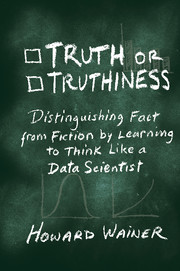Book contents
- Frontmatter
- Dedication
- Contents
- Preface and Acknowledgments
- Introduction
- Section I Thinking Like a Data Scientist
- 1 How the Rule of 72 Can Provide Guidance to Advance Your Wealth, Your Career, and Your Gas Mileage
- 2 Piano Virtuosos and the Four-Minute Mile
- 3 Happiness and Causal Inference
- 4 Causal Inference and Death
- 5 Using Experiments to Answer Four Vexing Questions
- 6 Causal Inferences from Observational Studies: Fracking, Injection Wells, Earthquakes, and Oklahoma
- 7 Life Follows Art: Gaming the Missing Data Algorithm
- Section II Communicating Like a Data Scientist
- Section III Applying the Tools of Data Science to Education
- Section IV Conclusion: Don't Try Th is at Home
- Bibliography
- Sources
- Index
5 - Using Experiments to Answer Four Vexing Questions
from Section I - Thinking Like a Data Scientist
Published online by Cambridge University Press: 05 December 2015
- Frontmatter
- Dedication
- Contents
- Preface and Acknowledgments
- Introduction
- Section I Thinking Like a Data Scientist
- 1 How the Rule of 72 Can Provide Guidance to Advance Your Wealth, Your Career, and Your Gas Mileage
- 2 Piano Virtuosos and the Four-Minute Mile
- 3 Happiness and Causal Inference
- 4 Causal Inference and Death
- 5 Using Experiments to Answer Four Vexing Questions
- 6 Causal Inferences from Observational Studies: Fracking, Injection Wells, Earthquakes, and Oklahoma
- 7 Life Follows Art: Gaming the Missing Data Algorithm
- Section II Communicating Like a Data Scientist
- Section III Applying the Tools of Data Science to Education
- Section IV Conclusion: Don't Try Th is at Home
- Bibliography
- Sources
- Index
Summary
Quid gratis asseritur, gratis negatur.
Introduction
In Chapter 3 we discussed how an observed correlation between high self-esteem (happiness) and school performance gave rise to various causal theories, at least one of which, if acted upon, could lead to unhappy outcomes. We saw how a simple experiment, by measuring the size of the causal effect, could provide evidence that would allow us to sift through various claims and determine the extent to which each was valid or specious. Every day we encounter many correlations that some claim to indicate causation. For example, there is a very high correlation between the consumption of ice cream and the number of drownings. Some cautious folk, seeing such a strong relation, have suggested that eating ice cream should be sharply limited, especially for children. Happily, cooler heads prevailed and pointed out that the correlation was caused by a third variable, the extent of warm weather. When the weather is warm, more people go swimming, and hence risk drowning, and more people consume ice cream. Despite the high correlation, neither eating ice cream nor swimming tragedies are likely to cause the weather to warm up. We could design an experiment to confirm this conjecture, but it hardly seems necessary.
After it was noted that infants who sleep with the lights on were more likely to be nearsighted when they grew up, advice to new parents was both rampant and adamant to be sure to turn the lights off when their baby went to sleep. Only later was it revealed that nearsightedness has a strong genetic component and nearsighted parents were more likely to leave lights on. Again, a controlled experiment – even a small one, though practically difficult to do – would have made clear the direction and size of the causal connection.
As one last example, consider the well-known fact that men who are married live longer, on average, than those who are single. The usual causal inference is that the love of a good woman, and the regularity of life that it yields, is the cause of the observed longer life. In fact, the causal arrow might go in the other direction. Men who are attractive to women typically are those who are healthier and wealthier, and hence more likely to live longer.
- Type
- Chapter
- Information
- Truth or TruthinessDistinguishing Fact from Fiction by Learning to Think Like a Data Scientist, pp. 43 - 60Publisher: Cambridge University PressPrint publication year: 2015



